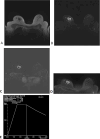A case of high-grade adenosquamous carcinoma of the breast: case report and literature review
- PMID: 40104510
- PMCID: PMC11915217
- DOI: 10.3389/fonc.2025.1548036
A case of high-grade adenosquamous carcinoma of the breast: case report and literature review
Abstract
High-grade adenosquamous carcinoma (HGASC) is a rare and aggressive subtype of metaplastic breast cancer (MpBC). This article reports a case of HGASC (pT2N0M0 Stage IIA) in a 43-year-old female and reviews the relevant literature, with a specific focus on distinguishing HGASC from other MpBC subtypes, particularly low-grade adenosquamous carcinoma (LGASC). The patient underwent a skin-sparing mastectomy with abdominal rectus myocutaneous flap reconstruction. Histopathology confirmed HGASC with metaplastic features. Postoperative adjuvant chemotherapy with capecitabine was administered. The case highlights the unique clinical, imaging, and pathological characteristics of HGASC, its therapeutic challenges, and the need for individualized treatment strategies. A five-month follow-up showed no signs of recurrence or metastasis.
Keywords: adjuvant chemotherapy; breast cancer surgery; case report; high-grade adenosquamous carcinoma; metaplastic breast cancer.
Copyright © 2025 Xing, Li, Fan, Wang, Wang, Liao and Zhang.
Conflict of interest statement
All authors declare that the research was conducted in the absence of any commercial or financial relationships that could be construed as a potential conflict of interest.
Figures
Similar articles
-
Low-Grade Adenosquamous Carcinoma of the Breast: A Single-Center Retrospective Study and a Systematic Literature Review.Cancers (Basel). 2024 Dec 20;16(24):4246. doi: 10.3390/cancers16244246. Cancers (Basel). 2024. PMID: 39766145 Free PMC article.
-
Low-Grade Adenosquamous Carcinoma of the Breast: A Case Report.Case Rep Oncol. 2024 Dec 9;18(1):92-99. doi: 10.1159/000542764. eCollection 2025 Jan-Dec. Case Rep Oncol. 2024. PMID: 39980511 Free PMC article.
-
Metaplastic breast carcinoma: a rare and aggressive entity.Ann Med Surg (Lond). 2025 Jan 9;87(2):985-990. doi: 10.1097/MS9.0000000000002816. eCollection 2025 Feb. Ann Med Surg (Lond). 2025. PMID: 40110252 Free PMC article.
-
[Metastasing and relapsing "low grade" adenosquamous metaplastic breast cancer--is there a really indolent lesion? A description of three cases and review of literature].Ceska Gynekol. 2005 May;70(3):211-6. Ceska Gynekol. 2005. PMID: 16047925 Review. Czech.
-
Low-grade adenosquamous carcinoma of the breast: a review with focus on imaging and management.Acta Radiol Open. 2021 Apr 30;10(4):20584601211013501. doi: 10.1177/20584601211013501. eCollection 2021 Apr. Acta Radiol Open. 2021. PMID: 34017612 Free PMC article. Review.
References
Publication types
LinkOut - more resources
Full Text Sources



